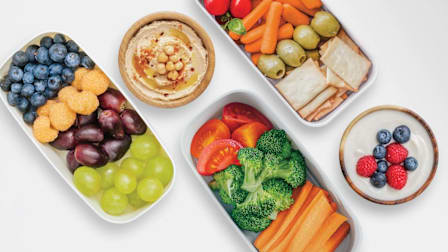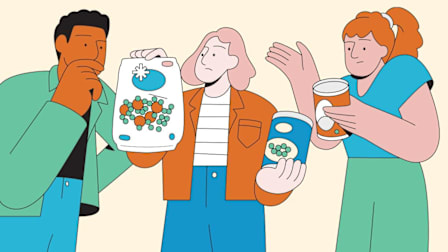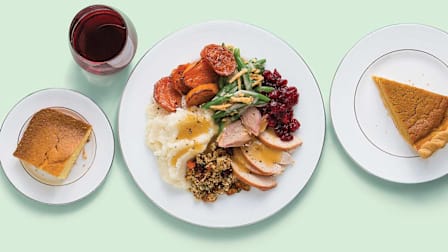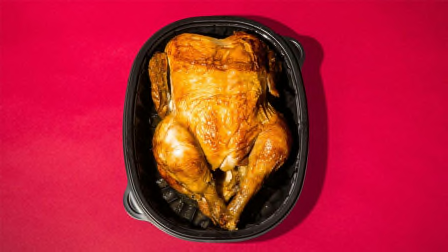Before You Drink Eggnog, Read This
CR shares a healthier way to enjoy this holiday treat
Next to fruitcake, eggnog may be the most polarizing holiday treat. But for those who embrace its rich flavor and distinctive nutmeg aroma, it’s one of the season’s top highlights, either on its own or as an ingredient in bread pudding, French toast, cookies, and cake.
A Serving of Eggnog Is Smaller Than You Think
Usually, the serving size for a drink is 1 cup (8 fluid ounces). But for eggnog, the serving size on the nutrition facts panel is just a half-cup. If you drink more than that, remember to double (or triple) the figures for calories, fat, and added sugars you see on the carton.
The nutritional content of different brands varies, but not by much. In our review of 30 eggnogs, the regular dairy versions had 170 to 210 calories, around 8 grams of total fat, and about 5 grams of saturated fat (although two brands had 9 grams). Added sugars ranged from a low of 7 to a high of 25 grams per serving, with most in the 15- to 17-gram range (that’s around 4 teaspoons). Adding an ounce (a little less than a shot glass) of rum, brandy, or other types of spirits tacks on 65 calories.
'Light' Eggnog Isn't So Light
When you’re scanning the selections of premade eggnog at a store, you’ll see several takes on the traditional recipe. Those labeled “reduced fat,” “low fat” or “light” typically contain about 140 calories and 3 to 6 grams of fat (about half from saturated fat) per half-cup serving. But the added sugar content is often similar to or only slightly lower than regular eggnog’s.
For example, Hood’s Golden Eggnog has 180 calories, 9 grams of fat, 5 grams of saturated fat, and 16 grams of added sugars. Its Light Eggnog has 140 calories, 4 grams of fat, 2 grams of saturated fat, and 17 grams of added sugars.
Among all the eggnogs we looked at, the dairy and egg versions with the least added sugars were Straus Family Organic Eggnog with 7 grams per half-cup and Bolthouse Farms Holiday Nog with 9 grams per half-cup. However, Straus was higher in calories (150 vs. 90) and saturated fat (6 grams vs. 1 gram).
Eggnog Has Some Redeeming Qualities
The eggnogs made with dairy and egg in our evaluation had 4 to 6 grams of protein in a half-cup. (Compare that with a large egg, which has 7 grams of protein.) You’ll also get between 10 and 20 percent of the 1,300 mg Daily Value for calcium and 2 to 6 percent of the 4,700 mg Daily Value for potassium, which helps keep blood pressure in check.
Plant-Milk Eggnogs Can Be Lower in Sugars and Saturated Fat
’Nog made from nut, oat, or soy milk will give you the flavor of the season, and it tends to be lower in calories and saturated fat because it doesn’t contain cream, eggs, or milk. (That means that these types of eggnog are lower in protein and calcium, too.)
Many of the ones we reviewed also have less added sugars than dairy versions. Harmless Harvest Coconut Nog Organic Smoothie (100 calories) has 2.5 grams of saturated fat and no added sugars. Califia Farms Almond Holiday Nog (50 calories) and Good Karma Flaxmilk Holiday Nog (45 calories) have 0 grams of saturated fat and 8 grams of added sugars per half-cup. Elmhurst Oat Nog (made with oats and cashews) has 100 calories, 0 grams of saturated fat, and 8 grams of added sugars. Malk Organic Holiday Nog (made with almond milk) has 60 calories, 0 grams of saturated fat, and 4 grams of added sugars.
Most Eggnogs Have Long Ingredients Lists
The flavor and creamy texture of many store-bought eggnogs—dairy and vegan—come in part from artificial and natural flavors, artificial colors, oils, and stabilizers and thickeners such as gums or carrageenan. (“Natural flavors” must come from a natural source but can be highly processed with chemicals and include many ingredients that don’t have to be disclosed.) Thickeners may cause digestive upset in some people and carrageenan has been linked to increased inflammation in the intestines. (Many of the plant milk eggnogs and organic dairy eggnogs did not contain carrageenan.) Several of the dairy products used high-fructose corn syrup as a sweetener.
The majority of the eggnogs we looked at had more than one of these ingredients. The exceptions were: Alexandre Family Farm Organic A2 Homegrown Eggnog, Family Farmstead 100% A2 Organic Eggnog, Malk Holiday Nog, and Straus Family Organic Eggnog. Kalona Supernatural Organic Eggnog and Elmhurst Oat Nog contain just one of these ingredients, natural flavors.
You Can Make Eggnog Healthier
Homemade eggnog can be even higher in calories, fat, and sugars than commercial versions. A half-cup serving of a traditional eggnog recipe spiked with bourbon or rum contains 265 calories, 17 grams of fat (half of which is saturated), and 18 grams of added sugars, but depending on the recipe it could have more.
Still, you can lighten up a recipe by substituting half and half for heavy cream and using about half the sugar called for.
It's Easy to Make Eggnog Safer
Classic eggnog recipes call for raw eggs. “Eggnog made with raw, unpasteurized eggs can contain salmonella, a leading cause of food poisoning,” says James E. Rogers, PhD, director of food safety research and testing at Consumer Reports. The bacteria can make anyone sick, but young children, older adults, pregnant people, and those with a weakened immune system are particularly vulnerable.
You can ensure that you and your guests are sipping safely, though, Rogers says. Almost all the eggnog sold in stores is pasteurized, which kills bacteria, but he says to be sure to check that the carton or bottle is clearly labeled as such.
If you make your own, use pasteurized liquid eggs, which are sold in a carton. Or heat raw eggs (mix them with milk and stir constantly) to 160° F to kill any salmonella bacteria that may be present before adding them to your recipe. “Don’t count on alcohol to kill the bacteria,” Rogers says. “The concentration isn’t high enough to reduce the risk of illness.”

















